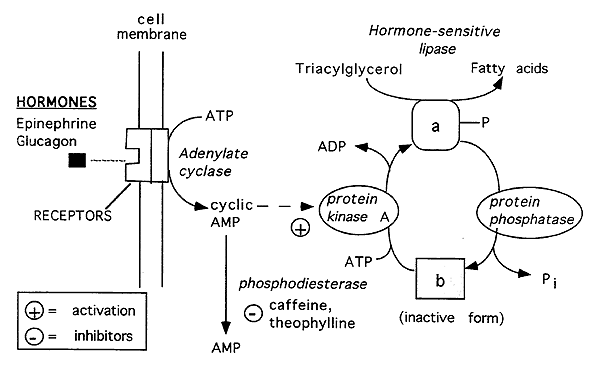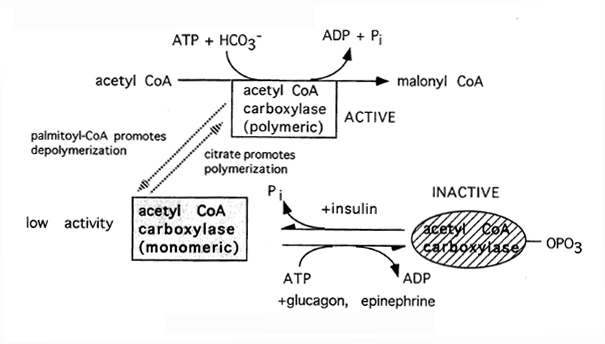
Fat Metabolism: Regulation and Integration
Regulation of Hormone-Sensitive Lipase (Lipolysis) : "Fasted" State

Phosphorylated- Active
Dephosphorylated- Inactive
Regulation of Acetyl CoA Carboxylase (Lipogenesis): "Fed" State

Allosteric Control:
Polymer- Active
Monomer- Inactive
Citrate ----> Polymerization ----> "Active" (lipogenesis)
Palmitoyl CoA ----> Depolymerization ----> "Inactive"
Covalent Modification:
Glucagon, Epinephrine (low glucose) ----> Phosphorylation ----> "Inactive" (while promoting lipolysis)
Insulin ----> Dephosphorylation ----> "Active"
Induction / Repression:
High CHO and Low Fat Diets ----> "Inductive" (increased synthesis)
High Fat Diet and Fasting ----> "Repression" (decreased synthesis)
Coordinated Control of Fat Synthesis and Breakdown via Acetyl CoA and Malonyl CoA:

Interrelationship of Fat and CHO Metabolism When Glucose is High:

Conditions Favoring Fat Synthesis (Lipogenesis):
CHO intake ----> Elevated Blood Glucose ----> Insulin High, Glucagon Low
Insulin (-) hormone sensitive lipase; (+) glucose utilization (glycolysis) and acetyl CoA production for lipogenesis
Citrate (+) acetyl CoA carboxylase
Malonyl CoA (-) carnitine palmitoyl transferase I (decreasing b-oxidation)
Conditions Favoring Lipolysis / b-Oxidation:
Starvation ----> Low Blood Glucose ----> Insulin Low, Glucagon High ----> (+) Lipolysis (free fatty acids for liver)
"Fight or Flight" ----> Epinephrine High ----> (+) Lipolysis (energy for muscle)
Low Blood Glucose ----> (+) gluconeogenesis (decreasing "C" supply for lipogenesis)
Acetyl CoA Carboxylase- phosphorylated ("Inactive")
CPT I- "Active" (due to decrease in Malonyl CoA)
Interrelationship of Fat and CHO Metabolism When Glucose is Low:

Starvation:
Fatty Acids are Oxidized in Liver which Promotes Gluconeogenesis by:
(a) providing energy
(b) generating NADH
(c) forming acetyl CoA to activate pyruvate carboxylase
(d) producing citrate which increases F-1,6 bisPase activity
Comparison of Energy Yields and Oxygen Consumption:
1 NADH = 3 ATP
1 FADH2 = 2 ATP
Palmitate (3 molecules = 48 "C"s)
Step 1: b-oxidation to acetyl CoA (6 cycles); (1 NADH + 1 FADH2)/cycle
Step 1cont'd: 7 x 3 molecules 21 FADH2+ 21 NADH ==> +105 ATP; -42 O atoms
Step 2: Acetyl CoA oxidation via TCA cycle; (3 NADH, 1 FADH2, 1 GTP) / Acetyl CoA
Step 2 cont'd: 8(6 + 2) x 3 molecules: 24 Acetyl CoA ==> +288 ATP; -96 O atoms
Step 3: Acyl CoA formation (ATP --> AMP + PPi; 2 ATP / molecule)
Step 3 cont'd: 2 x 3 molecules: ==> -6 ATP
b-hydroxybutyrate (12 molecules = 48 "C"s)
Step 1: oxidation to acetoacetate via b-hydroxybutyrate DH
Step 1 cont'd: 1 x 12 molecules: 12 NADH ==> +36 ATP; -12 O atoms
Step 2: Acetoacetate cleaved to 2 acetyl CoA ( loss 1 GTP due to succinyl CoA diversion)
Step 2 cont'd: 1 x 12 molecules: -12 GTP ==> -12 ATP
Step 3: Oxidation of acetyl CoA via TCA cycle
Step 3 cont'd: 2 x 12 molecules: 24 Acetyl CoA ==> +288 ATP; -96 O atoms
Glucose (8 molecules = 48 "C"s)
Step 1: Aerobic glycolysis, 2 NADH (mal-asp shuttle) + 2 ATP/glucose
Step 1 cont'd: 2 x 8 molecules: 16 NADH + 16 ATP ==> +64 ATP; -16 O atoms
Step2: PDH
Step 2 cont'd: 2 x 8 molecules: 16 NADH ==> +48 ATP; -16 O atoms
Step 3: Oxidation of acetyl CoA via TCA cycle
Step 3 cont'd: 2 x 8 molecules: 16 Acetyl CoA ==> +192 ATP; -64 O atoms
| Fuel | Total ATP | O2 Used | ATP/"C" | CO2/O2 | ATP/"O" Atom |
| Palmitate | 387 | 69 | 8.12 | 0.7 | 2.80 |
| Ketone | 312 | 54 | 6.50 | 0.9 | 2.89 |
| Glucose | 304 | 48 | 6.33 | 1.0 | 3.17 |
Note: ATP / "O" Atom is a measure of "fuel" efficiency
Fats: produce more ATP per "C", however it is at the expense of more oxygen (ATP / O atom), thus the respiratory quotient (CO2 / O2) is the lowest.
Glucose: is the better fuel under conditions of O2 limitation, giving more ATP / O atom.
Ketones: in starvation increase the amount of O2 needed to burn fuel to CO2 (CO2 / O2) only a small amount as compared to fats. The energy yield per carbon for ketones is similar to glucose. The brains energy needs and O2 availability can be met nearly as well by ketones, as by glucose.
© Dr. Noel Sturm 2015